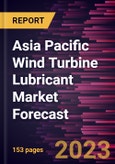Rising Focus of Manufacturers on Developing Bio-based Lubricants in Asia Pacific Wind Turbine Lubricant Market
In recent years, there has been an increasing interest among manufacturers to produce lubricants from bio-based sources. The use of biodegradable lubricants helps to avoid disastrous consequences in the case of accidental spillages. Oil leaks from wind turbines pollute the soil and water. In wind turbines, many lubricants such as oils and greases are based on mineral oils that cause pollution if they leak. If these lubricants are leaked into the sea, the clean-up process is challenging. However, oil leaks can be avoided by using bio-based lubricants, as they cause no pollution and degrade naturally if they leak. Lubricants are required in various applications in a wind turbine, such as in bearings, couplings, and gears, as well as in hydraulic systems. In these components and systems, the use of effective alternatives with low environmental impact, such as bio-based lubricants with a wide temperature range, ensures reliable operation. The use of bio-based lubrication products for wind turbines is beneficial in the analysis of environmental consequences. As a result, manufacturers are focusing on developing reliable products with an extended service interval and a low ecological footprint. Hence, the development of bio-based lubricants is expected to fuel the wind turbine lubricants market growth during the forecast period.Asia Pacific Wind Turbine Lubricant Market Overview
The wind turbine lubricants market in Asia Pacific is segmented into Australia, China, India, Japan, South Korea, and the Rest of Asia Pacific. China is a major contributor to the market growth in this region. The country has been the world's largest and fastest-growing producer of renewable energy for more than a decade. Moreover, it has the world’s largest wind energy market. China remained the world’s largest market for new onshore additions in 2020, driven by the feed-in tariff (FiT) cut-off. India also records the remarkable growth of the wind power industry due to policies and regulations adopted by the union and state governments. In Japan, the government has set the target of 10 GW of offshore wind installation by 2030 and 30-45 GW by 2040. According to the IEA Wind TCP, Japan’s wind power capacity reached 4,581 MW by the end of 2021. The Japan Wind Power Association stated that the country installed 232.9 MW of new wind capacity in 2022, bringing the total capacity in operation to 4,802 MW. Thus, the increasing installed wind capacity in China, Japan, India, and Australia, among others, drives the demand for wind turbine lubricants. Countries such as Taiwan, South Korea, Vietnam, and the Philippines are also taking various initiatives to further their installed wind capacities, adding to the region's demand for wind turbine lubricants.Asia Pacific Wind Turbine Lubricant Market Revenue and Forecast to 2028 (US$ Million)
Asia Pacific Wind Turbine Lubricant Market Segmentation
The Asia Pacific wind turbine lubricant market is segmented into base oil, product type, and country.Based on base oil, the Asia Pacific wind turbine lubricant market is segmented into mineral oil, synthetic, and bio-based. The synthetic oil segment held the largest share of the Asia Pacific wind turbine lubricant market in 2022.
Based on product type, the Asia Pacific wind turbine lubricant market is segmented into grease, gear oil, hydraulic oil, and others. The gear oil segment held the largest share of the Asia Pacific wind turbine lubricant market in 2022.
Based on country, the Asia Pacific wind turbine lubricant market is segmented into the Australia, China, India, Japan, South Korea, and Rest of Asia Pacific. China dominated the Asia Pacific wind turbine lubricant market in 2022.
TotalEnergies SE, BP Plc, Chevron Corp, Exxon Mobil Corp, Fuchs Petrolub SE, Kluber Lubrication GmbH & Co KG, Phillips 66, Shell plc, The Lubrizol Corp, Afton Chemical Corp, and AMSOIL Inc are some of the leading companies operating in the Asia Pacific wind turbine lubricant market.
Table of Contents
Companies Mentioned
- TotalEnergies SE
- BP Plc
- Chevron Corp
- Exxon Mobil Corp
- Fuchs Petroblub SE
- Kluber Lubrication GmbH& Co KG
- Phillips 66
- Shell Plc
- The Lubrizol Corp
- Afton Chemical Corp
- AMSOIL Inc








